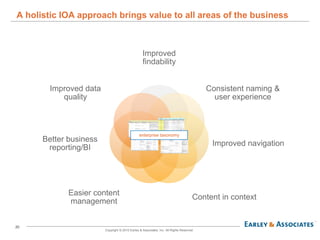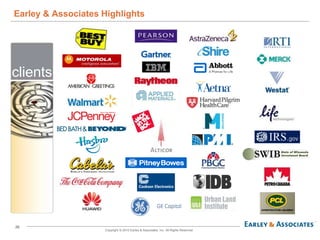Building internal-competencies-in-ioa
- 1. Building Internal Competencies in Taxonomy, Metadata and Information ArchitectureAIIM Information Organization and Access Course Overview
- 2. Recording AvailableA recording of this webinar can be found here:https://earley.ilinc.com/join/ctrmwct
- 3. Earley & Associates HighlightsFounded 1994 Focus Areas Holistic approach to specific business contexts and goals for: • Retail • Manufacturing • Pharmaceuticals & Life Sciences • Public Sector • Media & Entertainment Personnel Core team of 25 consultantsLocations Concord, MA headquarters, consultants in US, UK & Canada, global projectsServices • Taxonomy & Information Architecture • Search Strategy for Enterprise & Web • ECM, DAM & Information Lifecycle • Program Management & Governance
- 4. Seth Earley, Founder & President, Earley & AssociatesCo-author of Practical Knowledge Management from IBM Press
- 5. 16 years experience building content and knowledge management systems, 20+ years experience in technology
- 6. Former Co-Chair, Academy of Motion Picture Arts and Sciences, Science and Technology Council Metadata Project Committee
- 7. Founder of the Boston Knowledge Management Forum
- 8. Former adjunct professor at Northeastern University
- 9. Currently working with enterprises to develop knowledge and digital asset management systems, taxonomy and metadata governance strategies
- 10. Founder of Taxonomy Community of Practice – host monthly conference calls of case studies on taxonomy derivation and application. http://finance.groups.yahoo.com/group/TaxoCoP
- 11. Co-founder Search Community of Practice: http://tech.groups.yahoo.com/group/SearchCoP
- 12. AgendaWho/what is AIIM?The role of Information Organization and Access ProfessionalsWhat industries are actively developing IOA professionalsThe advantage of developing in-house resources vs. hiringThe AIIM Master Certificate course overviewWho should attend
- 13. AIIM is the community that provides education, research, and best practices to help organizations find, control, and optimize their information.AIIM was founded in 1943 as the National Microfilm Association and later became the Association for Information and Image Management. AIIM is also known as the enterprise content management (ECM) association. Today, AIIM is international in scope, independent, and implementation-focused. As the industry's intermediary, AIIM represents the entire industry - including users, suppliers, and the channelAs a neutral and unbiased source of information, AIIM serves the needs of its members and the industry through a variety of activities including research, education, advocacy, and networking.About AIIM
- 14. Imagine this product management scenarioWhat does the label look like?What are the ingredients, and where do they originate?Who purchased it? Through what channels?How do we market it?When was it made?Your response to a product recall depends on your information classification.Example courtesy Leslie Owens of Forrester
- 15. IOA FrameworkData ContentTaxonomy and Metadata provides linkage between structured data and unstructured contentExample courtesy Leslie Owens of Forrester April 2010 Taxonomy Community of Practice call
- 16. IOA Framework for Enterprise ApplicationsRelated documentsBrowsing & filteringCustomer Relationship MgtCompare productCase Example:Motorola’s Global Taxonomy FrameworkServed Multiple ProcessesBusiness intelligenceProgram Management Product Lifecycle Management
- 17. A Simple User Experience Requires IOA FrameworkCase Example:American Greetings Developing a technical model of content, assets and processes……becomes the foundation for a flexible, intuitive user experience
- 18. What is IOA?Information Organization and Access (IOA) is a disciplinethat operationalizes methods and practices used to create, apply and maintain consistent organizing principles across structured and unstructured information, processes, content and applications. IOA is at the convergence of Data Architecture, Enterprise Information Architecture and Semantic Architecture
- 19. Enterprise architecture is supported by IOA approachesEnterprise architecture “A comprehensive framework used to manage and align an organization's Information Technology (IT) assets, people, operations, and projects with its operational characteristics. In other words, the enterprise architecture defines how information and technology will support the business operations and provide benefit for the business.” The National Institutes of Health http://enterprisearchitecture.nih.gov/About/What/Enterprise Information Architecture Initiatives Require IOA Foundational Approaches in Order to Achieve Long Term Success
- 20. The IOA Professional Integrates Parallel Perspectives What is the difference between a data architect, a taxonomist and an information architect? Data architects are concerned with structured data and technical aspects of applications and database designTaxonomists are concerned with unstructured content semantics and the meaning of termsInformation architects consider how structured data elements, unstructured content meaning and user intent combine to form the user experienceWhat they have in common is that they are all IOA professionals
- 21. What’s missing?Organizations employ data architects, enterprise architects, information architects, taxonomists and library scientistsThe missing element is a common framework and foundational approaches that bring these perspectives together. Organizations that have an integrated approach include financial services, insurance, retail, public sector, consulting, life sciences, technologyThe challenge is that many of these initiatives are focused on particular applications or silos of the business and not truly enterprise in nature Taxonomy and metadata standards are part of IOA. Very few organizations have comprehensive global taxonomies
- 22. What is the Value IOA Training?Creates a holistic approach to information management that significantly improves the return on information assets and investmentsIntegrates best practices in information organization and governance into the fabric of information technology programs and projects. Improves maturity of the organization in content processes, taxonomy, metadata and information architecture Facilitates development of internal competencies and expertise allowing for a continuous cycle of improvement
- 23. The Role of Taxonomy and Metadata in IOAUnstructured and Structured applications are undergoing an unprecedented convergence - Leslie Owens of Forrester(April 2010 Taxonomy Community of Practice Conference call http://www.earley.com/webinars/business-processes/role-taxonomy-enterprise-architecture Complimentary access with code IOA410) Taxonomy and Metadata become the integration framework for structured and unstructured information
- 24. Taxonomy is Foundational to MetadataCommon language for…business processes
- 25. sharing concepts
- 27. unifying enterprise systemsHelps fine tune searchOrganizes content to make it findableAllows for consistent reportingThis is the “O” in IOA
- 28. Search is HeterogeneousData SourcesBusiness IntelligenceDocument repositoriesIntranets/web pagesCustomer Relationship MgtCustom databases and applicationsIOA/Taxonomy FrameworkAuto categorization/ClusteringEntity ExtractionFaceted SearchSemantic SearchAppliancesFederated SearchSearch Mechanisms
- 29. Content is HeterogeneousEnterprise Content ManagementSpans Structured and Unstructured ProcessesControlled ProcessesChaotic Processes Accessing informationAnswering questionsProblem solvingCollaborationKnowledge ReuseKnowledge CreationLESS STRUCTUREMORE STRUCTURELearning ManagementRecords ManagementDocument ManagementEmail ManagementInstant MessagingBlogsCLASS of TOOLProcess ManagementCollaborative SpacesWeb Content ManagementDigital Asset ManagementWikisIOA/Taxonomy Framework19
- 30. A holistic IOA approach brings value to all areas of the businessenterprise taxonomy
- 31. Example Trends Which Require Integrated IOA ApproachBusiness Intelligence needs metadata on structured data as the basis for quantitative analysis, taxonomy on unstructured content for the results of analysisExtend traditional quantitative BI with qualitative BI from unstructured content once a taxonomy is applied:analysis of risk/no risk claims by disease categoryanalysis of call center issues by product to monitor a recallanalysis of ad placement effectiveness by social media contextMaster Data Management needs taxonomy – both aim to define a “single version of the truth”MDM to eliminate structured data redundancyTaxonomy to eliminate unstructured content ambiguity
- 32. A Holistic View of IOA (Taxonomy and Metadata)Content ManagementEnterpriseSearch,Portal Design,CollaborationWebsiteNavigation,Search &SEOTaxonomy,Metadata, IA& UsabilityDigital AssetManagementRecords ManagementWorkflow ManagementRightsManagementSecurity & Privacy Management
- 33. Taxonomy allows for multiple perspectivesProductsSystem for organizing concepts and categorizing contentHierarchical relationships (parent/child)Tree-like structure, categories that branch out to reveal sub-categories and termsDictionary of preferred terminologyKey observation: taxonomy is not the same as navigation. GamesAction figuresCard gamesBoard gamesBrandMilton BradleyDisneyScrabbleBattleshipInternal perspectives may be different from what is important to external audiences.
- 34. Each system will leverage taxonomy slightly differentlyFASTE commerce suiteReconcile vendor product metadata with structure and format for catalog, merchandising, order managementDigital Asset ManagementGuided navigationFacets and attributes based on taxonomy resolve with search user experience best practicesStructure and terminology to support non text asset location and reuseProduct taxonomyCross sell/up sellContent managementSemantic relationships for related products, controlled terminology for merchandisers to support specific promotions Content and document types, topics/subjects, audiences, etc to support unstructured informationwww.Bestbuy.com
- 35. Creating in House CompetenciesProject FocusConsulting projects have a defined life spanFocused on a specific outcomeAre able to get the attention of the organization for limited time frameSnap shot in time, but enterprise is a moving targetMany times directed toward a specific application or systemPractice FocusOngoing life spanCenter of excellence modelBecome woven into the fabric of the organization Allow for continuous improvementGoal is to speed information flow, not organize information in placeThe only way to have long term success is to build enterprise competencies
- 36. Creating in House CompetenciesHiring resourcesDifficult to get trained resourcesMany have industry specific knowledge that may or may not applyLess understanding of internal processesCannot hire enough resources to meet the needs or the organizationMay not have up to date knowledge and expertiseTraining internal resourcesHome grown can be time consuming, but ultimately may staff up faster over long runBetter knowledge of business needs and cultureLess expensive than hiring high priced talentCan train a wider range of stakeholders and non specialistsCan train stakeholders on best practices, build common approachTraining is a viable approach to building competencies across the organization, not with just a few individuals
- 37. Course OverviewHalf day briefing for managers - $300High level overview of the topics of the courseAppropriate for managers or non specialists who want the high pointsTwo day Practitioner Course - $1160Focused on strategy, theoretical framework, planning projectsCovers taxonomy, ontologies, content modelingResults in Practitioner CertificateTwo day Specialist Course - $1160Focused on the how to of projectsUser analysis, scenarios, content inventorying, standardsIncludes governance, case studies, maturity modelsResults in Specialist CertificateFour day Master Class - $2980Practitioner and Specialist plus take home case studyResults in Master Certificate
- 38. Who Should AttendHalf day briefing is for professionals in non IT areas, directors, business managers, leadership, who want to understand principles and practices and the role of taxonomy, metadata and information architecture in enterprise search, content management, business intelligence First two days are for people who want a solid foundation in theory supporting improved content processes, taxonomy, metadata, content modeling and search approachesDays 3 and 4 are for information professionals and business users who want hands on knowledge of approaches. Much of day 3 and 4 are spent in group exercisesI would recommend that if you have the time, you attend the full 4 days and attain the Master certificateI keep the course practical and interactive and share best practices, example, deliverables and templates from actual engagements.
- 39. Earley & Associates Highlightsclients
- 40. Earley & Associates Core CapabilitiesStrategyProgram ManagementBusiness Analysis / User ResearchTechnology SelectionImplementation SupportSocialization & TrainingGovernanceSuccess Metricsskills
- 41. Questions?Seth Earley, PresidentEarley & Associates, [email protected]
Editor's Notes
- #13: The point here is that there are lots of definitions of enterprise architecture. This one was fairly succinct. The key is that it is a framework. When we look at organizations, we create a “domain model”. That domain model attempts to understand how people, systems, processes and organizing principles work together. This helps when developing new applications, integrating systems and improving the user experience when they interact with both structured and unstructured information
- #23: The point of this slide is to say that taxonomy brings a user centric approach to multiple systems and applications.































